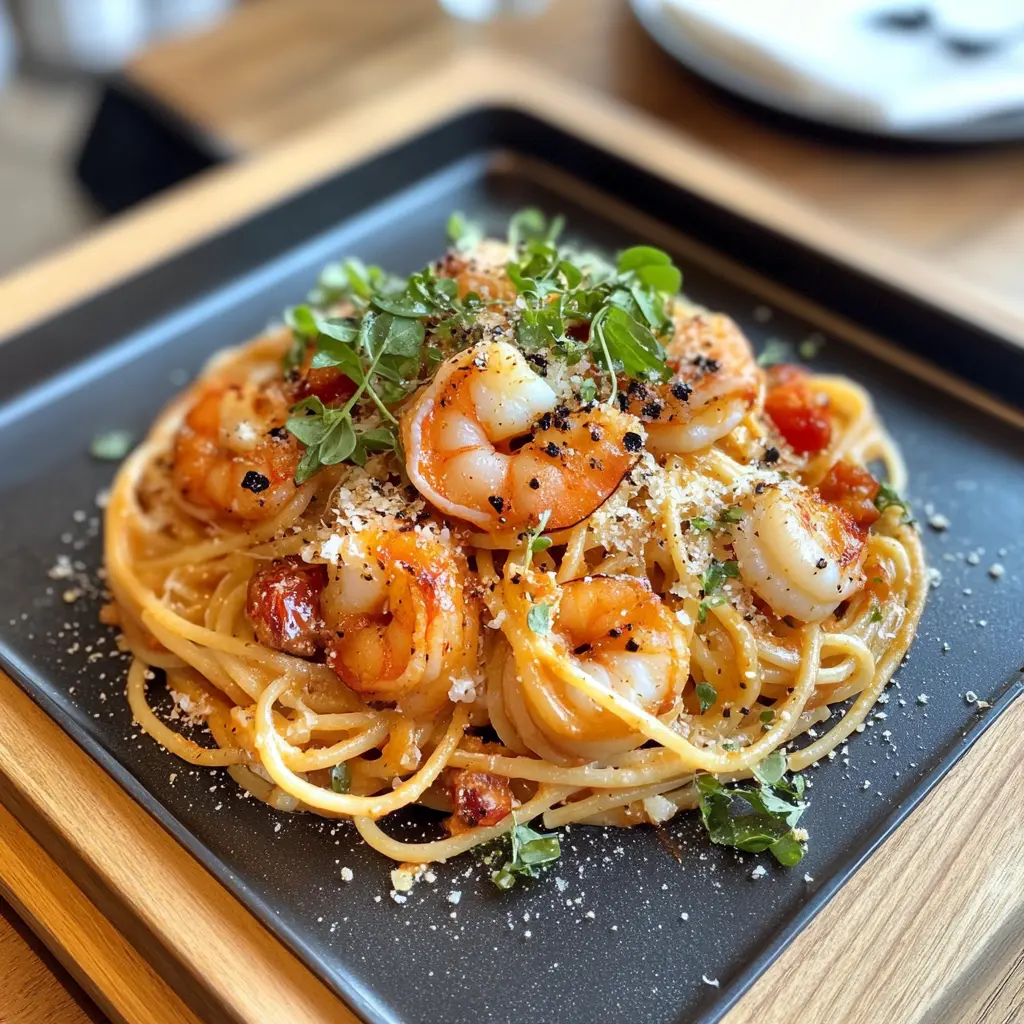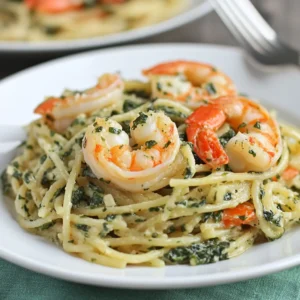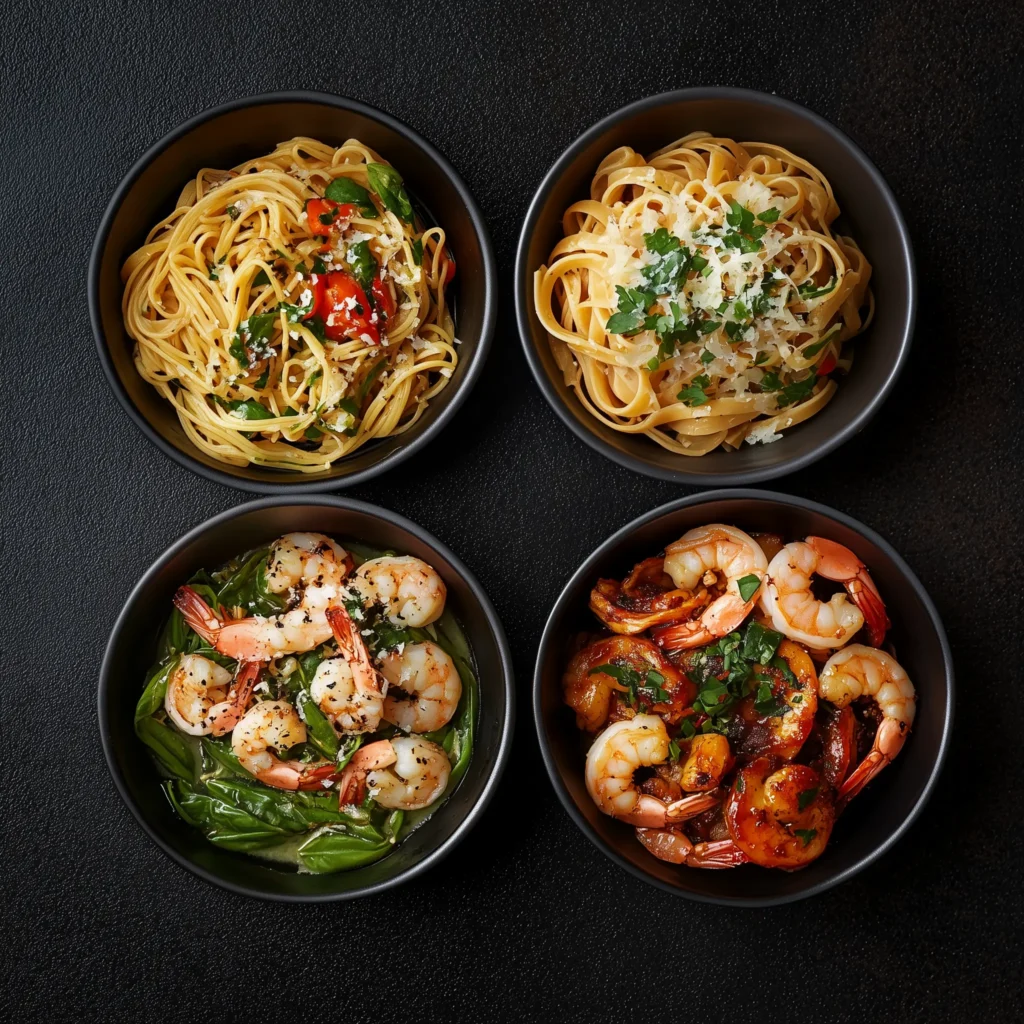Welcome to Quicky Cook Recipes! I’m Sophia Brooks, and I created this space for food lovers who crave quick, easy, and delicious meals, like this irresistible shrimp pasta recipe.
Every spoonful of this meal has a little piece of my story. It was born from a busy evening when I had just a few ingredients on hand—shrimp, pasta, garlic—and a hungry family waiting. In under 30 minutes, I had a comforting, flavorful meal on the table. That’s the magic I aim to share with you.
At QuickyCook, I believe cooking should be simple, stress-free, and full of joy. Growing up in a small town, I learned from my mom and grandma that food connects us. Now, I bring that same love to you with recipes designed for real life, minimal prep, everyday ingredients, and big taste.
Whether you’re new to the kitchen or just short on time, this shrimp pasta recipe is a perfect example of how easy homemade cooking can be.

Table of Contents
Why You’ll Love This Easy Shrimp Pasta Recipe
Benefits That Make This Dish a Keeper
- ✅ Quick Prep: Ready in 30 minutes or less
- ✅ Simple Ingredients: Most are already in your pantry
- ✅ Versatile Flavors: From lemony light to creamy rich
- ✅ One-Pan Option: Fewer dishes, more time for you
- ✅ Customizable: Spice it up or keep it classic
This isn’t just a weeknight meal. It’s your go-to recipe for last-minute guests, romantic dinners, or feeding picky eaters with ease.

Shrimp Pasta Recipe That Brings Flavor, Comfort, and Simplicity to Your Table
Equipment
- Large pot
- Large skillet
- Colander
Ingredients
Pasta
- 12 oz linguine or fettuccine Substitute with gluten-free or penne
Shrimp
- 1 lb shrimp peeled and deveined, medium or large, tail-off preferred
Sauce
- 2 tbsp olive oil Butter works too, for a richer taste
- 4 cloves garlic minced; always go fresh if possible
- 0.5 tsp red pepper flakes optional; for a mild heat
- 2 tbsp lemon juice brightens up the dish
- 0.5 cup heavy cream optional; for a creamy version
- 0.5 cup Parmesan cheese grated; adds umami and depth
- 2 tbsp fresh parsley chopped; for garnish and freshness
- salt and pepper to taste; adjust to your liking
Instructions
- Boil the pasta: Cook until al dente. Reserve ½ cup of the pasta water before draining.
- Season and cook the shrimp: Pat dry and sprinkle with salt and pepper. Sauté in olive oil until just pink (2-3 minutes per side).
- Make the sauce: Add minced garlic and red pepper flakes to the pan. Sauté until fragrant. Stir in lemon juice and reserved pasta water.
- Optional creamy version: Add heavy cream and bring to a simmer. Stir in grated Parmesan until melted.
- Combine pasta and shrimp: Toss everything together in the pan. Adjust seasoning. Add more pasta water if needed.
- Finish and serve: Top with chopped parsley and extra cheese. Serve warm.
Notes
Ingredients You’ll Need for Shrimp Pasta
Fresh, Flavorful, and Pantry-Friendly
| Ingredient | Amount | Notes |
|---|---|---|
| Shrimp (peeled & deveined) | 1 lb | Medium or large, tail-off preferred |
| Pasta (linguine/fettuccine) | 12 oz | Substitute with gluten-free or penne |
| Garlic (minced) | 4 cloves | Always go fresh if possible |
| Olive oil | 2 tbsp | Butter works too, for a richer taste |
| Red pepper flakes | ½ tsp (optional) | For a mild heat |
| Lemon juice | 2 tbsp | Brightens up the dish |
| Heavy cream (optional) | ½ cup | For a creamy version |
| Parmesan cheese | ½ cup grated | Adds umami and depth |
| Fresh parsley | 2 tbsp chopped | For garnish and freshness |
| Salt & pepper | To taste | Adjust to your liking |
How to Make Shrimp Pasta at Home – Step-by-Step
Foolproof Instructions for Restaurant-Worthy Results
- Boil the pasta
- Cook until al dente. Reserve ½ cup of the pasta water before draining.
- Season and cook the shrimp
- Pat dry and sprinkle with salt and pepper. Sauté in olive oil until just pink (2-3 minutes per side).
- Make the sauce
- Add minced garlic and red pepper flakes to the pan. Sauté until fragrant. Stir in lemon juice and reserved pasta water.
- Optional creamy version
- Add heavy cream and bring to a simmer. Stir in grated Parmesan until melted.
- Combine pasta and shrimp
- Toss everything together in the pan. Adjust seasoning. Add more pasta water if needed.
- Finish and serve
- Top with chopped parsley and extra cheese. Serve warm.
Tips for the Best Shrimp Pasta Recipe
Pro Secrets That Elevate Your Dish
- 📅 Use wild-caught shrimp for the best texture and taste
- 🧰 Don’t overcook your shrimp; they turn rubbery fast
- ☕ Deglaze the pan with white wine for extra depth
- 🌿 Want to switch things up? Try adding some spinach for freshness, sun-dried tomatoes for a tangy twist, or a handful of capers for a little bold bite.
- 🍿 Don’t forget to save a splash of that pasta water—it’s like liquid gold and works wonders to bring your sauce together.
Shrimp Pasta Variations You’ll Want to Try
From Spicy to Creamy – There’s a Style for Everyone
- Garlic Butter Shrimp Pasta
- Creamy Cajun Shrimp Linguine
- Shrimp Scampi with Angel Hair
- Lemon Basil Shrimp Spaghetti
- Shrimp Alfredo Penne Bake
Mix and match herbs, spices, and sauces depending on your mood or what’s in your kitchen.

How to Store and Reheat Shrimp Pasta
Keep It Fresh for Later
Storage Tips:
- Pop any leftovers into an airtight container and keep them in the fridge, good for up to 3 days of deliciousness.
- Not ideal for freezing; shrimp can get tough when reheated.
Reheating Tips:
- Warm gently in a skillet with a splash of water, broth, or cream.
- Avoid the microwave if you want to preserve texture.
Nutritional Snapshot (Approx. Per Serving)
| Nutrient | Amount |
|---|---|
| Calories | 480 kcal |
| Protein | 28g |
| Carbs | 44g |
| Fat | 22g |
| Fiber | 2g |
| Sodium | 510mg |
Conclusion: Bring the Taste of the Sea to Your Table Tonight
Shrimp pasta doesn’t need to be fancy or time-consuming to be delicious. With a few simple ingredients and the right steps, you can create a meal that feels indulgent, nourishing, and satisfying. Whether you’re feeding your family or treating yourself, this shrimp pasta recipe is one you’ll come back to again and again.
Ready to give it a try?
Leave a comment, share your twist, and tag @QuickyCook on social media. Don’t forget to follow us in Facebook for more 30-minute dinner ideas!
Frequently Asked Questions About Shrimp Pasta Recipe
What is the best sauce to eat with shrimp?
The best sauce for shrimp depends on the flavor profile you’re going for! A garlic butter sauce is a classic that enhances shrimp’s natural sweetness. For something richer, a creamy Alfredo or Cajun cream sauce adds depth and spice. If you want it lighter, try a lemon garlic sauce or white wine reduction—they keep things fresh and zesty without overpowering the shrimp.
Do you cook shrimp before adding to pasta?
Yes, shrimp should be lightly cooked before adding to pasta. They only need 2–3 minutes per side until they turn pink and opaque. You can cook them directly in the same pan as your sauce or sear them separately for more control. Be careful not to overcook, as shrimp can become rubbery quickly.
What pasta shape goes best with shrimp?
Linguine, fettuccine, and spaghetti are great choices because their long strands catch sauces well and pair beautifully with bite-sized shrimp. If you’re going for a chunkier or creamy sauce, penne or rigatoni are also excellent since they hold sauce inside their ridges and tubes.
What pairs well with shrimp?
Shrimp pairs well with a wide range of ingredients, including:
Fresh herbs like parsley, basil, or cilantro
Citrus (especially lemon or lime) for brightness
Garlic and chili flakes for heat and aroma
Cream, wine, or butter-based sauces
Veggies like spinach, asparagus, bell peppers, or cherry tomatoes
Carbs such as pasta, rice, or crusty bread
Add a side salad or steamed vegetables to round out your shrimp pasta meal perfectly.
